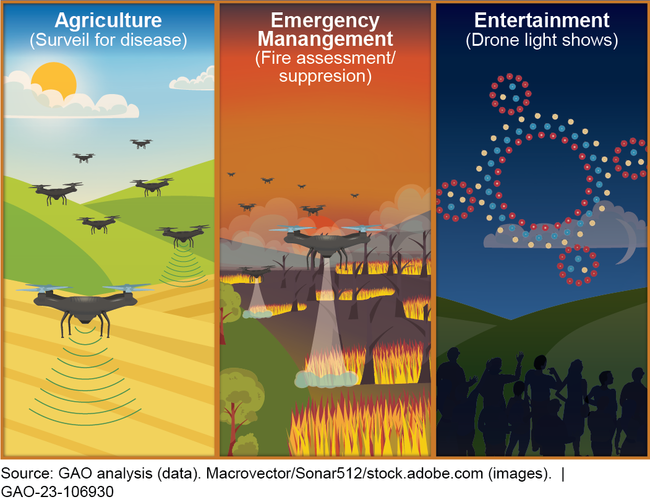Science & Tech Spotlight: Drone Swarm Technologies
Fast Facts
This Science & Tech Spotlight report explores drone swarm technologies, which use algorithms and local sensors to coordinate drones with minimal human intervention. Swarms could range from a few drones to possibly thousands. Advances in artificial intelligence and drone components have made swarms possible—even if they're limited to simpler missions like aerial light shows for now.
As the technology improves, it could be used to fight wildfires, detect crop disease, and more. However, it also raises concerns over safety, privacy, and cybersecurity. For example, a hacker could redirect a drone swarm for malicious purposes.

Highlights
Why This Matters
Drone swarm technologies allow groups of drones to coordinate with each other, often without direct human control. Potential civilian applications include fighting wildfires and finding missing persons. But advances are needed in computing and communication to realize these applications, and the technology may raise safety, cybersecurity, and privacy concerns.
The Technology
What is it? Drones are uncrewed aerial vehicles ranging in size from an inch to a wingspan of over 130 feet. Drone swarm technologies coordinate at least three and up to thousands of drones to perform missions cooperatively with limited need for human attention and control. For example, an aerial drone swarm could potentially assist with controlling a wildfire, assessing damages, finding access points, and suppressing the fire by raining firefighting liquids on it—all with minimal human direction. Drone swarms may be more efficient and robust for certain applications than single drones because swarms can complete a variety of tasks in parallel without human supervision. And they can continue operating if individual drones become inoperable.
How does it work? Drone swarms integrate advanced computer algorithms with local sensing and communication technologies to synchronize multiple drones to achieve a goal.
Drone swarms can use various methods of command and control, including preprogrammed missions with specific predefined flight paths, centralized control by a ground station or a single control drone, or distributed control where the drones communicate and collaborate based on shared information. More advanced methods of control include swarm intelligence, inspired by the collective behaviors of insect colonies and flocks of birds, as well as artificial intelligence techniques to teach drone swarms to respond to new or unexpected situations.

Figure 1. Methods of drone swarm command and control
How mature is it? Drone swarm technologies and algorithms have become more mature in recent years. Advancements in artificial intelligence and machine learning have improved decision-making and obstacle avoidance. High-speed communications technologies such as 5G and 6G networks have improved real-time data sharing among devices. Other advancements include energy efficient components, such as lighter materials and energy efficient motors, as well as advanced sensing technologies for environment mapping. In addition, there are now high-resolution cameras and infrared sensors for surveillance, reconnaissance, and search and rescue.
Despite these advances, drone swarm use remains limited due to a number of challenges. Most current drone swarm applications are still relatively simple. For example, aerial light displays are conducted with preplanned motions. Tasks such as tracking and determining the positions of multiple drones in uncontrolled environments still pose a significant challenge for drone swarm technologies. Weather conditions in emergency management situations like hurricanes or wildfires could exacerbate these challenges.
Opportunities
Current and potential civilian applications of drone swarm technologies include:
- Agriculture: Drone swarm technologies could plant seeds, identify disease outbreaks by surveilling large areas, and deploy treatments such as fertilizers to crops.
- Emergency management: Responders could use drone swarms to find missing persons and deliver emergency care and supplies during natural disasters.
Drone swarms could also help firefighters track and control the spread of wildfires and collect information about damages, access points, and more. - Entertainment: Event organizers have used drone swarms for entertainment as an alternative to fireworks. Doing so can mitigate debris, pollution, fires, and disturbances to animals and humans.

Figure 2. Current and potential civilian applications of drone swarms
Challenges
- Safety and security: Drone swarms can operate with minimal human intervention, but human intervention with control systems may be necessary for sensitive missions, such as those that could put humans in danger. Federal law prohibits drone swarm operation in restricted areas or for illegal or nefarious activities like spying, cyber-attacks, or deployment of improvised explosive devices. Operators must obtain a waiver to operate a drone swarm, as current regulations do not permit a person to operate more than one drone at the same time.
- Privacy and cybersecurity: Drone swarms collect information about their surroundings, so protocols need to be in place to protect against the collection and storage of certain information, such as photographs, videos, or sound recordings of individuals. Cybersecurity measures could help ensure drones are not hijacked or hacked by bad actors and used for malicious purposes.
- Technical advancements: Some applications will require miniaturization of hardware, such as sensors, as well as improved computing power. Advancements in algorithms could better simulate swarm behavior and improve connectivity, communications, and decision-making among drones.
Policy Context and Questions
- What actions could be taken to ensure drone swarm technologies operate safely?
- What threats may arise from the use of drone swarm technologies for illegal activities, and how may they be mitigated?
- What standards may be used or developed to ensure (1) the privacy of information that could be collected by drones and (2) appropriate cybersecurity protections?
- How could research initiatives address key technical challenges and advance high-value, secure, and ethical applications for drone swarms?
For more information, contact Brian Bothwell at (202) 512-6888 or bothwellb@gao.gov.
